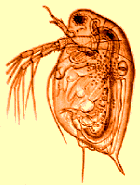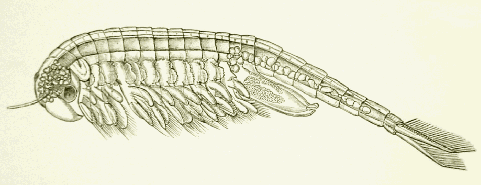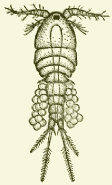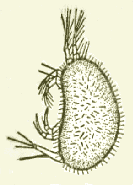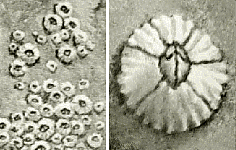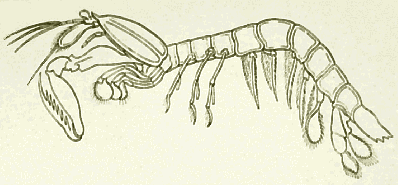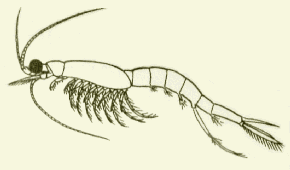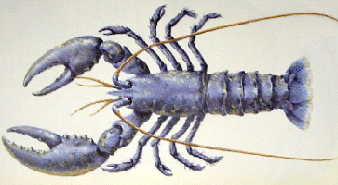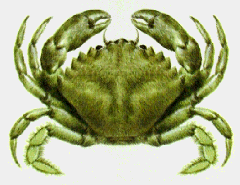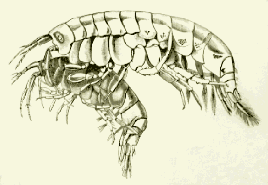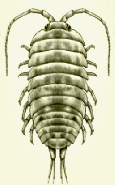
Consulting Entomologist

Tel/Fax: 01275 854224
E-Mail: [email protected]
Site Guide
Site Search
Home Page
Career Page
Insect Files
- Contents
- Bug Index
- The World of Bugs
- Classification of Bugs
- Insect Identification
- Insect Fossils
- Insect Body-parts
- Micro View of Bugs
- Insect Life Cycles
- Insect Defences
- Insects of Nailsea
- Pesticide Safety
- Bibliography
Shortcut to the main groups of insects and other arthropods...
Bug Rhymes & Poems
Links
Shop
Payments (credit/debit card)
Water Fleas to Crabs (Marine & Freshwater Crustaceans) |
Class: Crustacea Order: (various) |
| The dominant arthropods of our seas, rivers and lakes . . . . . . | |
|
The crustaceans are a large group of arthropods including nearly 40,000 species distributed worldwide. The vast majority are aquatic, living in all kinds of marine and freshwater habitats, and even in inland brines, which may have several times the salt concentration of seawater. Water fleas, shrimps, lobsters and crabs are among the best-known aquatic crustaceans, but the group also includes an enormous variety of other aquatic forms without popular names. A number of species are semi-terrestrial (or amphibious), such as the so called land crabs, but all these crustaceans have aquatic larval stages and they must return to the water for spawning when their eggs are ready to hatch. The only crustaceans that have properly invaded the land, without having to return to water for breeding, are the woodlice (belonging to the Order Isopoda), although mostly they still live in fairly damp places, with just a few species able to survive in very dry habitats (deserts, etc.). |
|
General Body Structure |
|
The crustacean body is difficult to characterize due to the great variety of forms among the different Orders of the group. In general the body is divided into three regions - the head, the thorax and the abdomen. The head and thorax (or just part of the latter) are often fused together to form a combined head and thoracic region (the cephalothorax) covered by a carapace. The head typically has two pairs of antennae (the first pair usually called antennules), and also several pairs of sensory and feeding appendages associated with the mouthparts. Most crustaceans have a pair of compound eyes, which are often mounted on stalks articulated on the head, so allowing movement of the eyes in different directions. The thorax and abdomen are segmented, with each segment bearing a pair of limbs, although in various groups the limbs are atrophied or completely missing on certain segments. The thoracic segmentation may be evident only on the underside in those forms with a cephalothoracic carapace. The limbs of the thorax and abdomen may be differentiated into distinct groups to perform different functions - feeding, swimming, walking or as organs used in reproduction - depending on the life-style of the animal. In many species, one or more pairs of the front thoracic limbs are modified to form pincers or other raptorial devices used for catching prey or for tearing away small pieces of food. The lobsters and crabs usually have a single pair of very large and obvious pincers, but some of the prawns may have up to three pairs of limbs each with less conspicuous pincers. The crustacean abdomen typically bears an unsegemented region at the rear-end called the telson or 'tail', which may be forked, with various hair-like or spine-like processes, or paddle-shaped and used for swimming (as in the 'fan-tail' of shrimps and lobsters). In crabs, both the abdomen and telson are much reduced and folded tightly under the thorax, so as to be more less hidden when the animals are viewed from above. Like other arthropods, custaceans have a hard outer covering, or exoskeleton, and growth occurs in a series of steps by periodic moulting of the exoskeleton. |
| <<< TOP |
Development & Life-cycle |
|
Many crustaceans have an elaborate life-cycle and metamorphosis during their development from eggs to adults. Some lay eggs freely in the water, whilst others retain the eggs in special brood pouches or attached to the abdominal appendages until they hatch. Typically the eggs hatch into a free-swimming, planktonic larval stage, generally quite different in appearance from the adult form. The larva develops through a series of moults, the last of which gives rise to a young stage that more or less resembles the adult. This stage then undergoes a further series of moults before reaching adult maturity. Some crustaceans have a sequence of different planktonic larval stages characterised by their structure, method of swimming or feeding, and other aspects of their behaviour. The common types are nauplius, metanauplius, protozoea, zoea, megalopa and cypris larvae. Some of these larval types are confined to certain groups, for example the megalopa is one of the developmental stages of crabs (Decapoda), whilst cypris larvae are found only in barnacles (Cirripedia). Crustacean development and metamorphosis rarely includes all the recognised larval types, with a sequence of just two or three types being fairly usual. Some crustaceans bypass the larval stages completely, and the young emerging from the eggs resemble the adults. This is found among many water fleas (Branchiopoda and Isopoda) and freshwater shrimps (Amphipoda), and in some freshwater crayfish and crabs (Decapoda). Some typical planktonic crustacean larvae are illustrated below. |
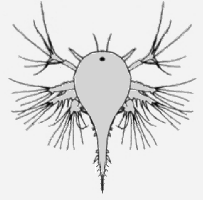 Nauplius Larva of a Barnacle length about 1 mm |
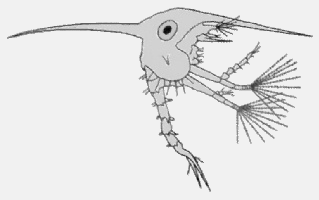 Zoea Larva of a Crab length about 2 mm |
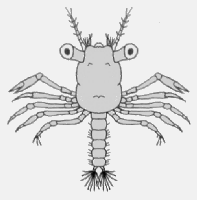 Megalopa Larva of a Crab length about 5 mm |
| <<< TOP | ||
Ecology |
|
Crustaceans play many roles in aquatic ecosystems. The planktonic forms, such as the copepod Calanus and the krill Euphausia, graze on the microscopic plants floating in the sea and in turn are eaten by fishes, seabirds, and baleen whales. Likewise, many benthic (bottom-dwelling) crustaceans are a food source for some fishes and toothed whales. Many crabs are important predators of marine molluscs and other invertebrates, whilst others play an important role as scavengers, clearing the dead remains of plants and animals from the seabed. Some crustaceans live as parasites, in particular many species of copepods, some known as fish lice and gill maggots, parasitize other aquatic animals ranging from sea anemones, marine worms and molluscs, to fishes and whales. Even the larger crustaceans are often parasitized by their smaller relatives, for example, there are some parasitic isopods that live in the gill chambers of decapod prawns. Some freshwater crustaceans (mainly crayfish and crabs) are intermediate hosts of the oriental lung fluke, Paragonimus, an unpleasant internal parasite of various carnivorous mammals, such as dogs, cats, etc., but which can also parasitize humans if they happen to eat raw or imperfectly cooked crayfish or crabs carrying the infective larval stages of the fluke. |
| <<< TOP |
Economic Importance |
|
The crustaceans of most obvious benefit and importance to humans are the larger edible species, chiefly decapods. Marine shrimps, prawns, lobsters and crabs are valuable sources of food, and thus of considerable economic importance to fishing industries throughout the world. Perhaps the most highly prized decapods are the true lobsters (Homarus species), regarded as a delicacies both in North America and in Europe. Freshwater crustaceans, including crayfish and some river prawns and river crabs, have local market value in many regions. The large acorn barnacle (Balanus psittacus), measuring up to 27 cm in length, is regarded as a delicacy in South America, and a stalked barnacle (Mitella pollicipes) is eaten in parts of France and Spain. In Japan, barnacles are allowed to settle and grow on bamboo stakes, later to be scraped off and crushed for use as fertilizer. Planktonic (i.e., drifting) copepods, such as Calanus and Euphausia, or krill, may be present in such great numbers that they discolour large areas of the open sea, thus indicating to fishermen where shoals of herring and mackerel are likely to be found. The water flea (Daphnia) and the brine shrimp (Artemia) are used as fish food in aquariums and fish ponds, and the larvae of the latter are widely used as food for the larvae of larger crustaceans reared in captivity. Some crustaceans, however, can become pests. For example, in parts of Asia much damage may be done to rice paddies by burrowing crabs and mud-eating shrimps of various species. By undermining paddy embankments, they allow water to drain away, thus exposing the roots of the plants to the sun, and in coastal areas salt-water may be allowed to seep into the paddies. Tadpole shrimps (Triops) are often numerous in rice fields, where they stir up the fine silt in search of food, killing many of the plants. In some areas, land crabs and crayfish sometimes invade and damage tomato and cotton crops. The stalked goose barnacles (Lepas) often attach themselves to boats below the waterline, and heavy encrustations of these animals may necessitate periodic dry-docking of vessels in order to scrap and clean the hull. |
| <<< TOP |
Fossil Record |
|
The fossil record of crustaceans, although fairly rich, has not so far provided any evidence of their early ancestry and evolution. The earliest known fossil crustaceans are ostracods, a relatively specialized group. These and other early fossils of the Cambrian Period*, dating around 505-540 million years old, indicate that many features of crustacean organization had already evolved by this time. Thus, crustaceans must have arisen from the primitive arthropod stock in Pre-Cambrian times, together with other ancient arthropod groups, such as the trilobites. The first shrimp-like decapods appear in Devonian* deposits (around 360-410 million years ago), crayfish occur in the Late Permian* (about 250 million years ago), and allies of the hermit crabs (Anomura) are found in the Jurassic* (145 to 210 million years ago). The true crabs, which represent one of the pinnacles of crustacean evolution, do not occur before the beginning of the Cretaceous* (around 65-145 million years ago). |
| <<< TOP |
| *See the Insect Fossils Page for the main Geological Periods of Earth History |
|
Fairy Shrimp (Chirocephalus) >>> |
|
| <<< TOP | GROUP INDEX >>> |
|
Copepoda (Water Fleas, Fish Lice) | |
|
Copepods can be conveniently divided into the free-living types, commonly called water fleas (e.g., Cyclops), and those that live as parasites on various marine invertebrates and on marine and freshwater fishes, such as the sea lice or fish lice (e.g., Lepeophtheirus), the gill maggots (e.g., Salmincola) and the anchor worms (e.g., Lernaea). Mainly small crustaceans, usually under 5 mm long (some parasitic forms larger, up to 20 mm). Free-living forms more or less resemble Cyclops (illustrated). No carapace, but the head and one or more thoracic segments fused to form a cephalothorax. Thoracic limbs short and inconspicuous. No abdominal limbs. Most have a single median eye. Head and appendages of female parasitic forms often highly modified for grasping or attaching to the host. Eggs carried in one or two egg-sacs attached to the first abominal segment (see illustration). Larva usually a nauplius. Marine, freshwater, and a few semi-terrestrial species. Many of the free-living species are planktonic, some brightly coloured or phosphorescent. Parasitic forms usually found attached to the skin, or living inside the mouth or gill chambers of the host. Fossils from the Miocene* (about 25 million years old). |
|
| <<< TOP | GROUP INDEX >>> |
|
Ostracoda (Seed Shrimps) | |
|
Tiny or small crustaceans, mostly under 5 mm long, with the entire head and body enclosed by an oval, more or less bean-shaped, bivalved carapace (hence their common name). Only the antennae and tips of other appendages protrude from between the valves of the carapace when the animal is active. Carapace varies little in shape between species, generally brownish in colour, sometimes patterned, sometimes with fine surface sculpturing, and usually with a fringe of hairs. Their uniform appearance makes ostracods easily recognisable as a group, but difficult to identify to species. Direct development without a nauplius or other larval stage. Marine, freshwater, and a few semi-terrestrial. Typically found scuttling about in vegetation or in the surface layers of bottom sediments, occasionally in open water. Crawl on the bottom using their legs and swim by beating their antennae. When threatened, they withdraw their appendages and clamp the two halves of the carapace tightly shut. Fossils from the Cambrian* (about 505-540 million years old, most known only from carapace remains). |
|
| <<< TOP | GROUP INDEX >>> |
|
Cirripedia (Barnacles) | |
|
A specialised group of marine crustaceans in which the adults are sedentary. Mainly free-living, some parasitic on other crustaceans. Adults of most free-living forms with the carapace developed as a mantle protected externally by several calcified plates, forming a hard shell that encloses the entire body. Some, like the goose barnacles (e.g., Lepas), have a stalk or peduncle for attachment to the substrate, whereas others, like the familar acorn barnacles (e.g., Balanus, Semibalanus, Elminus, etc.), are sessile (unstalked) with the limpet-like shell stuck directly onto rocks and other objects. The thoracic appendages can be protruded from the shell and by their beating action the barnacle filters and collects minute particles of plant or animal food floating in the water. Stalked species mainly found attached to drift wood, boats and other floating objects, although a few forms live in deeper water, attached to corals and worm tubes. Sessile species mainly found in shallow water and the intertidal zone, attached to rocks and almost any kind of seashore structures, such as masonry, metal or wooden breakwaters and pier stanchions. |
|
|
Adults of the parasitic barnacles are quite unlike the free-living goose and acorn barnacles. The best known example, Sacculina, develops as a soft, smooth, yellowish lump, attached under the abdomen of the common shore crab (Carcinus), and sometimes other crab species, in such a way as to prevent the abdomen of the parasitized crab from folding tightly under the thorax or carapace. The barnacle grows root-like structures which invade the body of the crab and extract nutrients from its internal organs. All barnacles have free-swimming nauplius and cypris larvae, the latter eventually settle and moult into the young sedentary stage, which then gradually develops to maturity. Fossils date back to the late Silurian* (about 400 million years old). | |
| <<< TOP | GROUP INDEX >>> |
|
Stomatopoda (Mantis Shrimps) | |
|
Moderate to large shrimp-like crustaceans, some up to 25 cm long. Head with two movable segments and a pair of stalked compound eyes. Carapace short, leaving last four thoracic segments uncovered. Second thoracic limbs large and modified into spiny, raptorial arms used for catching and crushing prey (similar to the praying mantids of the insect world). Abdominal swimming appendages well developed. Marine, living on the seabed in holes or in the sand, mainly in shallow coastal waters of warm or tropical seas, although sometimes occur in colder waters. Larvae largely unknown, but appear to include a zoea-type stage. Fossils from the Jurassic* (145-210 million years old). |
|
| <<< TOP | GROUP INDEX >>> |
|
Mysidacea (Opossum Shrimps) | |
|
Small or moderate sized, more or less transparent, shrimp-like crustaceans, most up to 30 mm long, with a few much larger. Head with movable, stalked eyes. Carapace well developed, covering most of thorax. Thoracic limbs lack pincers, branched and fringed with hairs, and mainly used for swimming. Abdomen characteristically humped with short appendages, except in males where the fourth pair of abdominal appendages are much elongated. Females carry their eggs in a ventral thoracic brood-pouch. Direct development with no larval stages. Worldwide distribution, usually free-swimming in open water, sometimes in shallow reaches but more often in deeper water well below the surface. Mainly marine, but some in brackish and fresh water. Fossils from the Triassic* (about 210-245 million years old). |
|
| <<< TOP | GROUP INDEX >>> |
|
Decapoda (Shrimps, Prawns, Lobsters, Crabs) | ||
|
Decapods include the familiar shrimps, prawns, lobsters, crayfish and crabs, amongst which are the largest of all living crustaceans, such as the giant Japanese spider crab (Macrocheira), which has legs that can span up to 3.7 metres, and the American lobster (Homarus americanus), which can weight up to 20 kilograms. |
|
|
|
All decapods have a large carapace covering the entire head and thorax, and enclosing the gills. Eyes usually stalked. First three pairs of thoracic appendages used for feeding, the other five pairs developed as walking legs in most species (from which the group gets its name), often with at least one pair bearing large pincers. Abdominal appendages used for swimming (and for carrying eggs in the female). The abdomen of shrimp-like forms (shrimps, prawns, lobsters, crayfish, etc.) terminates in a well developed 'fan-tail', which by flexing the abdomen can be used to propel the animal quickly backwards. Crabs have the abdomen and 'tail' (telson) much reduced and folded tightly under the thorax, so as to be more less hidden from above. The hermit crabs are characterised by a fleshy, asymmetrical abdomen, which is carried and protected inside an empty gastropod (snail) shell. The abdomen is coiled to fit the shell and the animal anchors itself inside by means of modified, hook-like terminal appendages. The other abdominal appendages are much reduced or absent. Most species develop through planktonic zoea and other larval stages, but some with direct development. Worldwide, mostly marine but also freshwater and a few semi-terrestrial forms. Fossils dating back to the Devonian* (360-410 million years old). | ||
| <<< TOP | GROUP INDEX >>> | |
|
Amphipoda (Freshwater Shrimps, Sand Hoppers) | ||
|
Robust, shrimp-like crustaceans, generally brown to olive or greyish in colour. Most up to about 25 mm in length, but some larger species up to about 140 mm. Body flattened from side to side. Eyes sessile, sometimes lacking. No carapace. Thoracic and abominal appendages used for burrowing and swimming. Direct development with no larval stages. Worldwide, mainly marine but also numerous in brackish and fresh water, including estuaries, rivers and lakes. Found under stones, in sand and gravel, or amongst living or dead vegetation, where they feed on all kinds of organic debris. Usually swim on their side. Males often seen clasping and carrying the females during the breeding season (as illustrated). Fossils from the Eocene* (40-60 million years old). |
| |
| <<< TOP | GROUP INDEX >>> | |
|
Isopoda (Sea Slaters, Water Lice, Hog Lice) | ||
|
Woodlouse-like crustaceans, commonly known as sea slaters, water slaters, water lice or hog lice. Usually greyish-brown in colour, rarely more than 30 mm long, but some larger up to 270 mm. Body flattened dorso-ventrally and without a carapace. Eyes sessile, sometimes lacking. Thoracic appendages usually modified as walking legs, and most forms have lost the ability to swim. Abdominal appendages flattened and serve a respiratory function. Some have larval stages, but many with direct development. Worldwide, in marine, freshwater, and terrestrial habitats. Most aquatic forms, like the common sea slater (illustrated), are bottom-living, found under rocks and stones, or crawling amongst bottom debris, especially decaying vegetation. A few parasitic species, which are highly modified as larvae and adults, live attached to other crustaceans or infest the gill chambers, mouths and skin of various fishes. The group includes the only true terrestrial crustaceans, the woodlice, which no longer need to return to water in order to breed. Fossils from the Carboniferous* (about 285-360 million years old). |
| |
| <<< TOP | GROUP INDEX >>> | |
| *See the Insect Fossils Page for the main Geological Periods of Earth History |
|
RELATED PAGES (Other Crustacea) |
| WOODLICE |

(classification of crustaceans) |
| <<< TOP | (use the back button on your web browser to return to the previous page) | TOP >>> |
